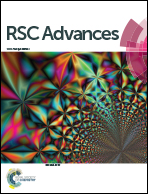Fabricating a morphology tunable patterned bio-inspired polydopamine film directly via microcontact printing†
Abstract
A robust and simple strategy of microcontact printing is provided to fabricate micro-patterned polydopamine (PDA) films with tunable morphology achieved by altering the concentration of PDA “ink” solution. Photoactive sites on the surface of patterned PDA films allow the further growth of polymer brushes by self-initiated photografting and photopolymerization (SIPGP) endowing the bio-inspired PDA films with various functionalities.


 Please wait while we load your content...
Please wait while we load your content...